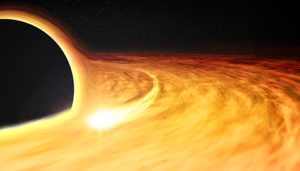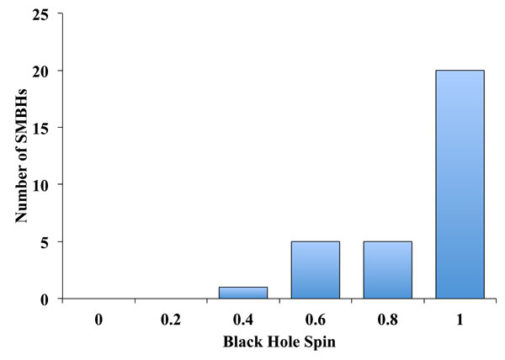The glow of a star torn up by a supermassive black hole has enabled researchers to measure how fast the black hole whirls around.
Astronomers have discovered a surprisingly long-lived X-ray pulse from the debris of a shredded star as it inexorably spirals closer to a black hole’s mouth. The pulse’s timing appears to be tied to the black hole’s spin and indicates that the black hole twirls at a speed at least 50% that of light.

NASA / CXC / M. Weiss
Spin is one of the fundamental parameters that describe a black hole, like the stats on an ID card. It’s immensely hard to measure; we only have spin measurements for about 30 supermassive black holes, determined based on their X-ray spectra.
Reporting January 9th in Science and at the winter American Astronomical Society meeting in Seattle, Dheeraj Pasham (MIT) and colleagues are adding another black hole to the list — but in an innovative way. The team used the lingering glow from a tidal disruption event (TDE), the catastrophic death of a star when it’s torn in two by a supermassive black hole. Half of the star gets flung away, like the vegetable on a child’s plate, while the other half is slowly swallowed. Astronomers estimate that any given galaxy’s central black hole should produce a TDE every 10,000 to 100,000 years or so, which translates into tens of events per year with current survey capabilities.
The TDE the team used in the study, ASASSN-14li, was discovered in November 2014. (The name is a reference to the survey project that found it, not a commentary on the black hole’s destructive act.) It’s one of the closest and best-studied TDEs astronomers have, confirming several phenomena predicted to come with these violent encounters — evidence of a jet, a hot accretion disk, and even material thrown out during the event, says Andrew Levan (University of Warwick, UK), who has studied ASASSN-14li but wasn’t involved with the current work.
For much smaller black holes, those a few times the mass of the Sun, astronomers have seen repeating blips in the glow of their tutu-like accretion disks when an extra dollop of gas is suddenly dumped on them. Pasham’s team decided to look for a similar quasi-periodic oscillation in the X-rays coming from ASASSN-14li.
Using archival observations from NASA’s Chandra and Swift space telescopes and the European Space Agency’s XMM-Newton, the researchers found a bright, periodic pulse that repeated every 131 seconds. The signal lasted a surprisingly long time — at least 450 days, a duration that Pasham says is “really bizarre.”
Levan agrees. “I’m quite surprised that it seems to be so stable for so long,” he says. “This signal is fascinating.”
To endure for more than a year, the pulse is likely related to material orbiting the black hole, both Pasham and Levan say. The team decided to assume that the glowing gas circles as close to the black hole as is physically possible; any stuff passing within this innermost stable orbit will instead plunge straight toward the event horizon. The researchers then calculated how tight this circuit would be, based on estimates of the black hole’s mass (about a million Suns). It turns out that, in order for the gas to get as close as the pulse’s frequency implies, the black hole has to be spinning rapidly, dragging the gas tightly around itself.

Laura Brenneman
The spin the team estimates — at least 70% of the black hole’s theoretical maximum, or at least 50% the speed of light — continues the trend followed by other supermassive black holes we have spins for, almost all of which spin at least 60% of their max. Most are much higher, nearly maximal. With only a couple dozen examples it would be premature to make big-picture conclusions (especially if we’re not interpreting the data correctly), but the pattern might indicate that supermassive black holes grow primarily by prolonged feeding from accretion disks, which would spin the black holes up like water from a hose hitting a basketball.
ASASSN-14li is the second TDE with a pulse, but the other example, SwiftJ1644+57, only lasted a few weeks after its discovery and was harder to study because the event powered a jet that pointed straight at us. “It is very exciting to see another case of X-ray flux oscillations in a tidal disruption event,” says Jon Miller (University of Michigan), who has also studied ASASSN-14li. He hopes that when the European Athena X-ray mission launches in 2031, it will find many more and really break open this line of investigation.
Reference:
Dheeraj R. Pasham et al. “A loud quasi-periodic oscillation after a star is disrupted by a massive black hole.” Science. January 9, 2019.
 2
2









Comments
Anthony Barreiro
January 10, 2019 at 6:08 pm
According to the Chandra X-Ray telescope database on ASASSN-14li, this supermassive black hole is 290 million light years distant, at RA 12h 48m, Dec +17deg 46min, in the southeastern corner of Coma Berenices, about halfway from Denebola to Arcturus. I know I won't see it through my little telescope, but I always like to know where things are in the sky.
You must be logged in to post a comment.
Gordon-Strader
January 13, 2019 at 3:31 am
When a black hole is said to be spinning at "50% of the speed of light", are we talking about the rotational motion of a point on the event horizon? Also, what constrains the max theoretical spin rate to about 71% of light speed, i.e. 50%/.7
You must be logged in to post a comment.
You must be logged in to post a comment.